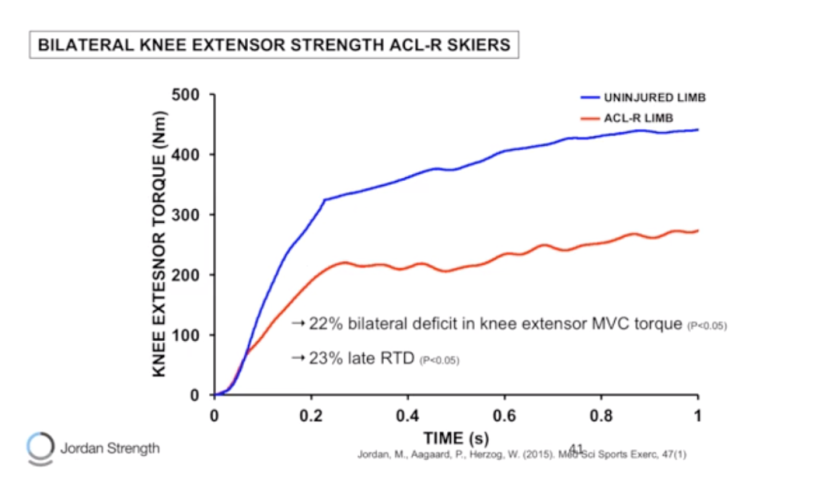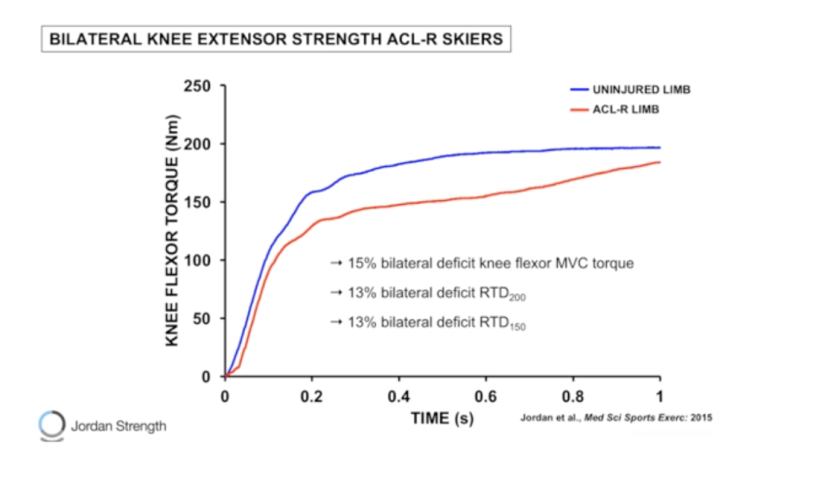RFD Hamstring / quadriceps ratio (RFD H:Q ratio)
One of the most debated discharged criteria for return to sports criteria after ACL reconstruction is the Hamstring to Quadriceps ratio when evaluating rehabilitation progression and making return to sport (RTS) decisions. The common assumption is that athletes who play pivoting sports and who pass strength tests as part of a RTS testing protocol are at lower risk for a second ACL injury. This underlying the importance of strength tests during rehabilitation, because return to sports is a continuous process that starts from the beginning of rehabilitation, and it is important to evaluate strength multiple times throughout rehabilitation. Regular testing allows for easy modification of strength training programs and tailor the training to the athlete’s status and needs.
P. Kyritsis (2016) found, beside meeting all the discharged criteria, that there for every 10% decrease in hamstring to quadriceps strength ratio, was a 10.6 times higher risk of sustaining an ACL graft rupture. The clinical advice was to give a careful attention to athletes achieving an appropriate hamstring to quadriceps strength ratio before discharge after ACL reconstruction as it may help to reduce the likelihood of secondary ACL graft rupture. Currently, the most accepted ratio is that hamstring should be 60% of the quadriceps strength. But this is only relevant if the quadriceps is 2.5/3 x peak torque to bodyweight. This is often measured by using a isokinetic device like the Biodex at a speed of 60 DEG/SEC.
In the below example, the quadriceps deficit is only 4.2%, however the Peak torque to BW is only 2.3 and 2.2 respectively. The hamstring deficit is 18.5% and this difference shows the right leg has a H:Q ratio at 59.9% whereas the left only has a H:Q ratio at 51%. If we increase the quadriceps strength, the H:Q ratio will be even lower. So in this example, a special attention should be given to develop hamstring strength as well as the quadriceps muscle strength.

Why is Hamstring / quadriceps ratio important.
The theoretical background why this ratio is important is that the contraction force of m. quadriceps during knee extension produces substantiel anteriorly directed shear force of the tibia relative to the femur at extended joint angles of 0–35 degrees of flexion (E Witvrouw, 2007). Therefore, a rapid co-activation of hamstrings, together with ACLR itself, can counteract and reduce this anterior shear force, which may be protectable factor the ACL.
Peak force or rate of torque development for Hamstring / quadriceps ratio
In a study by Jordan, M. Aagaard, P. and Herzog W looked at elite alpine skiers and ACL injuries. It is commonly known that the mechanism of ACL injuries occurs after 60ms after initial foot contact with a rapid increase in knee flexion 26 to 63 degrees in a combination of knee valgus and tibial internal rotation. The muscle above the knee, m. quadriceps, acting as an external force causing an anterior draw load on tibia and a passive strain in the ACL If the force is high enough the ACL can ruptured.
So, with this paper, at has been debated if we should look at the time to develop force and not only isokinetic peak torque result. But there is an indication, that if you have deficit in your peak torque you properly also have a deficit in your rate of torque development (explosive strength).

Furthermore, a cross-section study by Zebis et al, 2011 observed in a group of female football players, that a lower RFD H/Q in the initial phase of contraction, could be a possible risk factor for sustaining future ACL injury. Interestingly, the MVC H/Q ratio did not differ significantly amongst tested players.

In addition, another study by Ishøi et al. found an association between early hamstring RFD (0-100ms) with various measures of sprint performance in youth elite football players. The present data indicate that early-phase (0-100 ms) rapid force capacity of the hamstring muscles plays an important role for the acceleration capacity in elite youth football players. This indicates that strength training focusing on improving early-phase hamstring rate of force development may contribute to enhance sprint acceleration performance in this athlete population.
The relevance of this paper is that it supports not only look at the peak torque values for hamstring.
What is normative values for Hamstring / quadriceps ratio
Ishøi L et al (2021) also looked at hamstring and Quadriceps Muscle Strength in Youth to Senior Elite Soccer in a Cross-Sectional Study Including 125 Players. The main finding was that senior male elite soccer players had an 18% to 26% lower hamstring:Quadriceps (H:Q) ratio compared with younger players at the U13 to U19 level, which seemed to be mainly driven by senior players concurrently demonstrating lower hamstring strength combined with a higher quadriceps strength. This discrepancy in H:Q ratio may place senior players at increased risk of hamstring strain injuries especially considering the higher sprint running demands at the senior level compared with the youth level. These findings suggest that there could be a specific need for implementing hamstring strengthening exercises to improve hamstring capacity and/or focus more on posterior chain exercises at the senior level entering phase including ongoing monitoring of hamstring strength as a secondary prevention strategy. It may be important to consider for players who enter the senior elite level with a previous hamstring strain injury or end the previous season with low eccentric hamstring strength, as these players likely present in the new season with reduced hamstring capacity.

Furthermore, a new scoping review by Melick et all, 2022, looked at reference values to help guide clinicians regarding what is ‘normal’ strength for pivoting sport athletes, and what to expect during rehabilitation and RTS progressions after ACLR. When three or more studies reported on the same sport, they created a reference value table for the sport and grouped data from all other sports if data was reported in two or fewer studies.
Strength results from healthy soccer players were reported in 26 studies. There were data from 1987 soccer players (84% males) 152 aged a mean 24.0 ± 2.1 years (TABLE 2) (Melick et all, 2022).





Furthermore strength results from six studies of pivoting sport athletes with ACLR at a specific time point during rehabilitation were combined in TABLE 6 strength tests were completed at three, four, six, seven, nine and ten months after ACLR for 816 pivoting sport athletes with 174 ACLR (80% males) aged a mean 21.8 ± 3.0 years. After 7 months and beyond, strength 175 values for athletes with ACLR were comparable to those of healthy pivoting sport athletes



Reference
- Kyritsis P, Bahr R, Landreau P, et alLikelihood of ACL graft rupture: not meeting six clinical discharge criteria before return to sport is associated with a four times greater risk of ruptureBritish Journal of Sports Medicine 2016;50:946-951.
- Witvrouw E, Mahieu N, Roosen P, McNair P. The role of stretching in tendon injuries. Br J Sports Med. 2007;41(4):224-226. doi:10.1136/bjsm.2006.034165
- Jordan MJ, Aagaard P, Herzog W. Lower limb asymmetry in mechanical muscle function: A comparison between ski racers with and without ACL reconstruction. Scand J Med Sci Sports. 2015 Jun;25(3):e301-9. doi: 10.1111/sms.12314. Epub 2014 Sep 12. PMID: 25212216.
- Zebis MK, Andersen LL, Ellingsgaard H, Aagaard P. Rapid hamstring/quadriceps force capacity in male vs. female elite soccer players. J Strength Cond Res. 2011 Jul;25(7):1989-93. doi: 10.1519/JSC.0b013e3181e501a6. PMID: 21701286.
- Ishøi L, Aagaard P, Nielsen MF, Thornton KB, Krommes KK, Hölmich P, Thorborg K. The Influence of Hamstring Muscle Peak Torque and Rate of Torque Development for Sprinting Performance in Football Players: A Cross-Sectional Study. Int J Sports Physiol Perform. 2019 May 1;14(5):665-673. doi: 10.1123/ijspp.2018-0464. Epub 2019 Apr 19. PMID: 30427242.
- Ishøi L, Krommes K, Nielsen MF, Thornton KB, Hölmich P, Aagaard P, Penalver JJJ, Thorborg K. Hamstring and Quadriceps Muscle Strength in Youth to Senior Elite Soccer: A Cross-Sectional Study Including 125 Players. Int J Sports Physiol Perform. 2021 Apr 22:1-7. doi: 10.1123/ijspp.2020-0713. Epub ahead of print. PMID: 33887700.
- Van Melick N, van der Weegen W, van der Horst N. Quadriceps and Hamstrings Strength Reference Values for Athletes With and Without Anterior Cruciate Ligament Reconstruction Who Play Popular Pivoting Sports, Including Soccer, Basketball, and Handball: A Scoping Review. J Orthop Sports Phys Ther. 2021 Dec 31:1-35. doi: 10.2519/jospt.2022.10693. Epub ahead of print. PMID: 34972481.